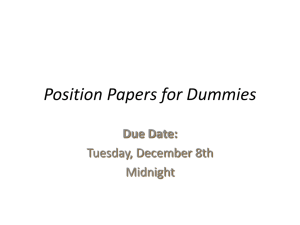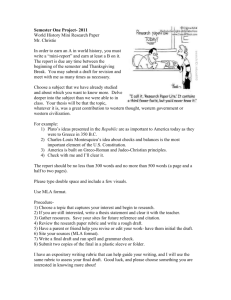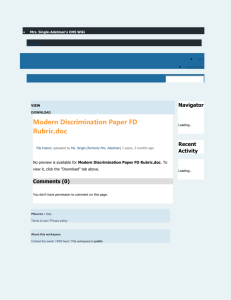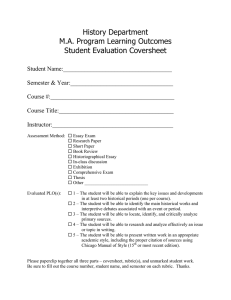Work Plan
advertisement
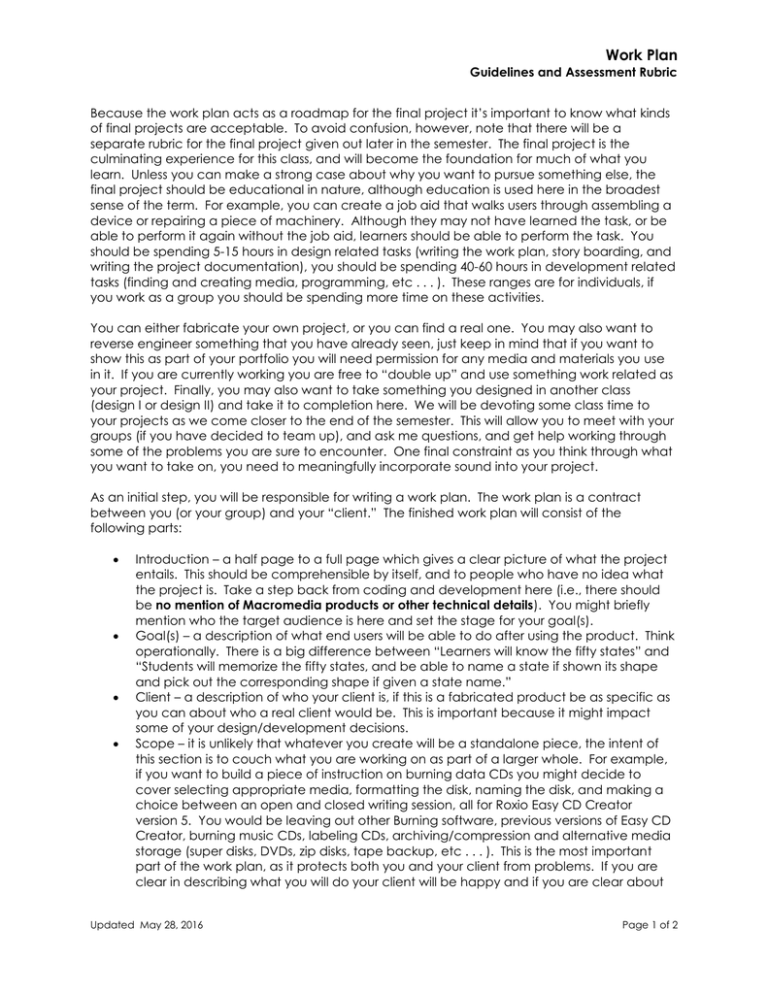
Work Plan Guidelines and Assessment Rubric Because the work plan acts as a roadmap for the final project it’s important to know what kinds of final projects are acceptable. To avoid confusion, however, note that there will be a separate rubric for the final project given out later in the semester. The final project is the culminating experience for this class, and will become the foundation for much of what you learn. Unless you can make a strong case about why you want to pursue something else, the final project should be educational in nature, although education is used here in the broadest sense of the term. For example, you can create a job aid that walks users through assembling a device or repairing a piece of machinery. Although they may not have learned the task, or be able to perform it again without the job aid, learners should be able to perform the task. You should be spending 5-15 hours in design related tasks (writing the work plan, story boarding, and writing the project documentation), you should be spending 40-60 hours in development related tasks (finding and creating media, programming, etc . . . ). These ranges are for individuals, if you work as a group you should be spending more time on these activities. You can either fabricate your own project, or you can find a real one. You may also want to reverse engineer something that you have already seen, just keep in mind that if you want to show this as part of your portfolio you will need permission for any media and materials you use in it. If you are currently working you are free to “double up” and use something work related as your project. Finally, you may also want to take something you designed in another class (design I or design II) and take it to completion here. We will be devoting some class time to your projects as we come closer to the end of the semester. This will allow you to meet with your groups (if you have decided to team up), and ask me questions, and get help working through some of the problems you are sure to encounter. One final constraint as you think through what you want to take on, you need to meaningfully incorporate sound into your project. As an initial step, you will be responsible for writing a work plan. The work plan is a contract between you (or your group) and your “client.” The finished work plan will consist of the following parts: Introduction – a half page to a full page which gives a clear picture of what the project entails. This should be comprehensible by itself, and to people who have no idea what the project is. Take a step back from coding and development here (i.e., there should be no mention of Macromedia products or other technical details). You might briefly mention who the target audience is here and set the stage for your goal(s). Goal(s) – a description of what end users will be able to do after using the product. Think operationally. There is a big difference between “Learners will know the fifty states” and “Students will memorize the fifty states, and be able to name a state if shown its shape and pick out the corresponding shape if given a state name.” Client – a description of who your client is, if this is a fabricated product be as specific as you can about who a real client would be. This is important because it might impact some of your design/development decisions. Scope – it is unlikely that whatever you create will be a standalone piece, the intent of this section is to couch what you are working on as part of a larger whole. For example, if you want to build a piece of instruction on burning data CDs you might decide to cover selecting appropriate media, formatting the disk, naming the disk, and making a choice between an open and closed writing session, all for Roxio Easy CD Creator version 5. You would be leaving out other Burning software, previous versions of Easy CD Creator, burning music CDs, labeling CDs, archiving/compression and alternative media storage (super disks, DVDs, zip disks, tape backup, etc . . . ). This is the most important part of the work plan, as it protects both you and your client from problems. If you are clear in describing what you will do your client will be happy and if you are clear about Updated May 28, 2016 Page 1 of 2 what you will not do your client will not be able to increase the scope without further increasing the budgeted time and/or the budgeted money. Target Audience – an indication of who will be using the product. Outline factors that will be critical to your design. For example, age, level of computer literacy, connection speed, etc . . . For those of you who have taken the Instructional Design class, this is not a full target audience analysis. Be brief. Limitations – a discussion of constraints under which the project has to be completed. All of you should have something to say about a limited amount of time, and most of you should also be able to note a non-existent or extremely small budget. Some of your limitations might also flow naturally from your target audience section (such as reduced connectivity or lower-end machines necessitating a smaller screen resolution). Finished Products – a list of what will be given to the client. At a minimum this should include the work plan, the storyboards, the project documentation, any development files, and the final exported files. You may also want to include things like a well organized set of related media. Timeline – this is a list and description of responsibilities for project completion. If you are working as a group, you should designate what each person is responsible for. Story board – This is a very rough idea of what critical interactions will look like. For those of you who have taken the design classes we will not be going to that level of detail. Instead, give me (and yourself) some idea of how you will use your real estate in the finished product. This can either be done with hard copy or electronically if you want to use a rapid prototyping methodology. Either way, graphics should be accompanied with a text description of what is going on in each screen. You should have between 3-5 story boards. Check the syllabus for due dates. Everything will be due before the stroke of midnight (23:59:59) on the date noted. More important than point values for each part are their corresponding percentage of your final grade (repeated above from the syllabus). The remaining 20% of your grade will be based on assignments. To give you more time to devote to your projects the assignments pretty much stop as we get closer to the end of the semester. Deliverables: Ideally, these will consist of a single MS Word document (or RTF file if you have another word processing program). Go ahead and “build” on existing work (so your second submission should include the intro and goals as well as the additional sections, the third should include everything even though only the storyboards will be new). You can revise the introduction and goals based on feedback I give you but once your final submission is in do not revise your work plan (even if you decide to modify your project partway through). Any significant changes to your design can be noted in your project documentation. File Naming convention: workPlan1YourName.doc (so if your name were Sam Walker you would submit workPlan1SamWalker.doc). (use .rtf if you submit a rich text format file). Please do not submit adobe acrobat files unless you arrange it with me beforehand. The second and third submissions would then be workPlan2SamWalker.doc and workPlan3SamWalker.doc. Assessment Rubric Your assignment will be assessed using the following rubric: Criteria Is your Work Plan clear, well written, and professional? Does your Work Plan include all of the required elements noted above? Total Updated May 28, 2016 Points 30 points 70 points 100 points Page 2 of 2
